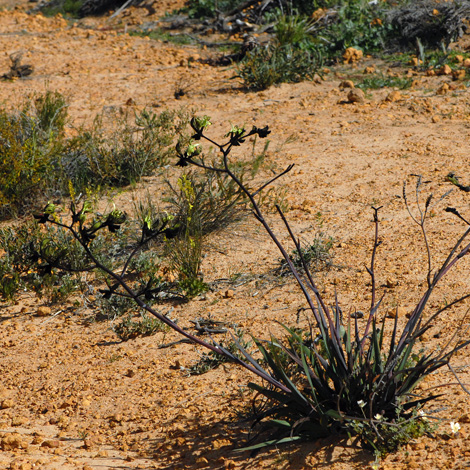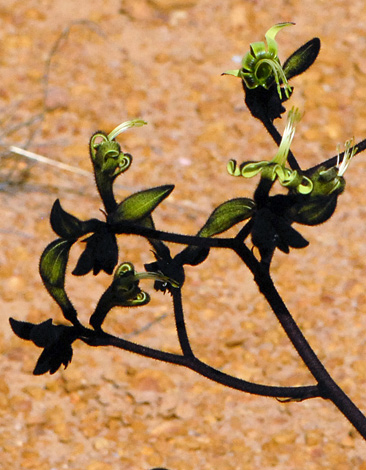Macropidia fuliginosa Black Kangaroo Paw Endemic



|

|

|

|
| Macropidia fuliginosa Black Kangaroo Paw | Macropidia fuliginosa Black Kangaroo Paw | Macropidia fuliginosa Black Kangaroo Paw | Macropidia fuliginosa Black Kangaroo Paw whole |
There is so much which is odd about this plant I hardly know where to begin. The first odd and amazing thing is the colour. The stems are purplish green but at the top are covered in plumose, sooty, black hairs which make it appear black except where the flower colour starts to appear.
In most Kangaroo Paws the colour at the top of the stem, which is more red and orange but exceptionally green, attracts the pollinating birds to the less conspicuous flower (very little pollination is done by insects) and the large nectary provides an excellent reward for a pollinator which can fly a lot further than an insect to release its pollen. Birds see the red end of the spectrum better than the blue but this plant appears black. Perhaps it is infra red radiation which attracts them? Unlikely because birds, like humans don't see into the infra red. Or are plant pollinating south Australian birds an exception to this generalisation?
This plant is also rare and unusual in that it is the only member of the genus Macropidia in the family Haemodoraceae. Macropus is the Latin for Kangaroo, -pidia refers to foot or paw and fuliginosa means sooty. It only grows in or near the coastal strip form Perth to just south of Geraldton and nowhere else in the world.
In this specific case I noticed a little white flower growing at the base of the plant (you can see it in the photo of the whole plant) . It turned out to be an even rarer plant Xanthosia tomentosa (Leseuer Southern Cross) which is a Priority 4: Rare, Near Threatened and other species in need of monitoring, listed plant. It grows in a much smaller region only around this particular national park.
Two rarities growing together! And I only spotted the Kangaroo paw as we zoomed past it at 30 mph on the unmade dusty roads of the Lesueur National Park.
Roadside, Lesueur National Park, south Western Australia 7th September 2012
Added on 12th December 2010, updated 9th August 2018



